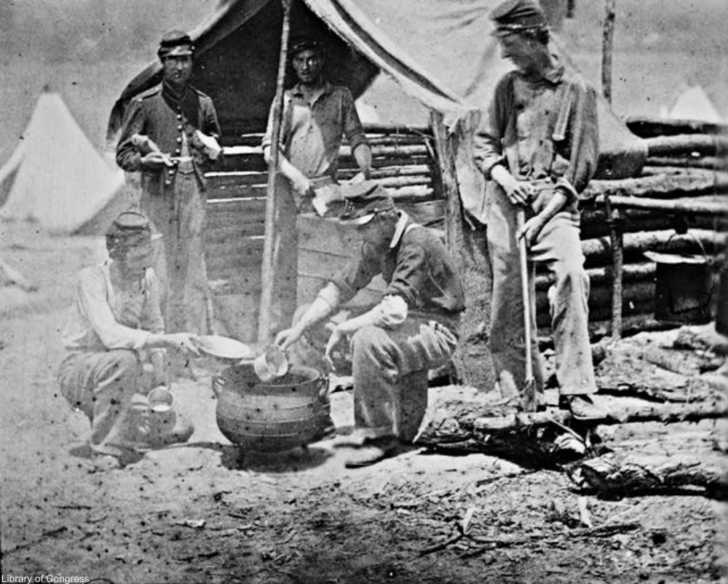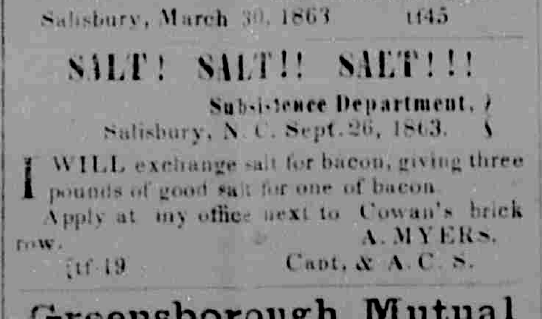Food Production In The North During The Civil War
By 1860 the free states had nearly twice the value of farm machinery per acre and per farm worker as did the slave states leading to increased productivity. Deeply researched in a wealth of primary-source materials incorporating the vast scholarly literature of.

What Exactly Did Civil War Soldiers Eat Dusty Old Thing
As Union armies penetrated the South they sent cotton to Britain.

Food production in the north during the civil war. Coffee and hardtack salt pork and skillygalee cornmeal and beef tea. Over the course of the war Georgia known as the antebellum Empire State of the South became an indispensable site for wartime manufacturing combining a prewar. Food in the Civil War was cooked over an open campfire in a cast iron skillet or kettle or occasionally on a spit.
Civil conflict and civil war have proven to be a human universal across cultures and eras. They sometimes ate the same thing day after day. Many of these comprised a number of small operations.
Ad Find old antique and rare food and drink books at Biblio. If history is any guide and if current events can be used as the canary in the coal mine it is only a matter. On the eve of the Civil War in 1861 the financial and banking system in the United States bore little resemblance to current institutions and practices.
With only meager rations soldiers on both sides of the battlefield had to get creative when it came to Civil War cooking. Which of the following was not an advantage the north had in the civil war greater numbers more food production more industrial capacity superior generals. The Agricultural Labor Shortage in the Northwest During the Civil War and How it was Met Unpublished dissertation.
Manufacturing might of the North during the Civil War 1861-65 often overshadowed that of the South but the success of the Confederate war effort depended as much on the iron of its industry as the blood of its fighting men. As a result in 1860 the Northern states produced half of the nations corn four-fifths of its wheat and seven-eighths of its oats. The Civil Wars Division of North and South is Reflected in Cookbooks.
Beef especially in corned beef. The North raised money to pay for the war by enacting the first income tax. The North was fighting on unfamiliar territory 5.
There was no central bank. Economically the Civil War led to. By 1860 North Carolina was one of the Souths leading industrial states with nearly 3700 manufacturing plants of all types capitalized at 97 million and producing products valued at 167 million.
The North and South battled for four years which lead to many deaths. The Battle of Gettysburg The battle started on. Answer Superior generals was not an advantage the north had in the civil war since although there were a number of talented generals in the North there were more in the South such as Robert E.
Statistics on specific industries provide what appears to be convincing proof. Miami OH University 1956. By 1860 the northern states had nearly twice the value of farm machinery per acre and per farm worker as did the Southern states leading to increased worker productivity.
Virginias Mineral Resources and the American Civil War. The soldiers looked forward to packages from home but often their families did not have enough to eat themselves. Iron provided not only bayonets and bridles but also skillets cauldrons canned rations axes saws shovels chains surgeons tools and countless pieces of.
Then Sherman went through with his total war. Significance - Women played a pivotal role during the Civil War by nursing the injured. Food during the Civil War was not high quality and did not taste good.
Decline of Iron Production and the Effects of the Civil War. King Wheat and King Corn which were produced in great quantities in the North proved to be more powerful than King Cotton. Most of the battles fought in the war were on southern farmplantations lands so anything growing there was gone.
When you think of military food the word delicious doesnt often come to mind. The Civil War helped solidify the Norths economic dominance over the South. Soldiers who fought in the war often did not get enough food.
While the loss of the Southern crop produced a steep war-long decline in production in the Norths largest industry cotton textiles its woolen industry enjoyed a 100 production rise during the conflict. Northerners liked Irish potatoes while Southerners preferred sweet potatoes. During the American Civil War iron provided the raw material for pistols rifles cannons land mines sabers and knives as well as railroad locomotives and ironclad warships powered by steam.
In Food and Agriculture during the Civil War Hurt provides an exhaustive examination of the production of foodand everything associated with itin both Northern and Southern societies during the American Civil War showing how the war shaped agricultural practices beliefs and policies and how in turn agriculture helped to determine the outcome of the war. By Staff Writer Last Updated Apr 14 2020 55812 AM ET. Naval blockades kept the South starving for salt and other foods a fact reflected in the recipes of the time.
North Carolinians suffered many hardships during the Civil War. The Civil War began when. A decline in prosperity for North and South alike b the emergence of a nation-state committed to national economic development c a tariff reduction to attract foreign goods to make up for the decline in domestic production.
About 125000 men from the state served in the Confederate army and others served in. If they had the time soldiers tried to devise ways of making their dull diet a little more varied occasionally catching wild game or picking wild berries. Agriculture and the Civil War.
The American Civil War was partly instigated over economic political and social differences between the Southern and Northern United States. As a result in 1860 the northern states produced half of the nations corn four-fifths of its wheat and seven-eighths of its oats. Potatoes were served in various forms including mashed boiled stewed baked and scalloped.
Meats included the ever popular pork especially in the South and West. In 1861 the cotton supply ran out and many British factory workers were laid off. However the South benefited from familiarity with their own terrain being resourceful and having the ability to produce all the food they needed.
When they did receive food it often was not very good. These are the foods of the American Civil War. And lamb or mutton generally in the Northeast and Southwest.
The North Fights the Civil War.

Economic And Political Differences Between The Union And Confederacy Yahoo Image Sea Civil War Lessons American History Projects Middle School Lesson Plans

Civil War Timeline For The Litwits Workshops Collection Of Free Teaching And Learning Resources F Civil War Timeline History Timeline American History Timeline
Economic Development During The Civil War And Reconstruction Us History I Ay Collection

Food During The Civil War From Tar Heel Junior Historian Ncpedia

Us Civil War Advantages In The North And South Your Students Can Create A Storyboard To Gather Civil War Activities Civil War Lesson Plans Civil War Lessons
Komentar
Posting Komentar